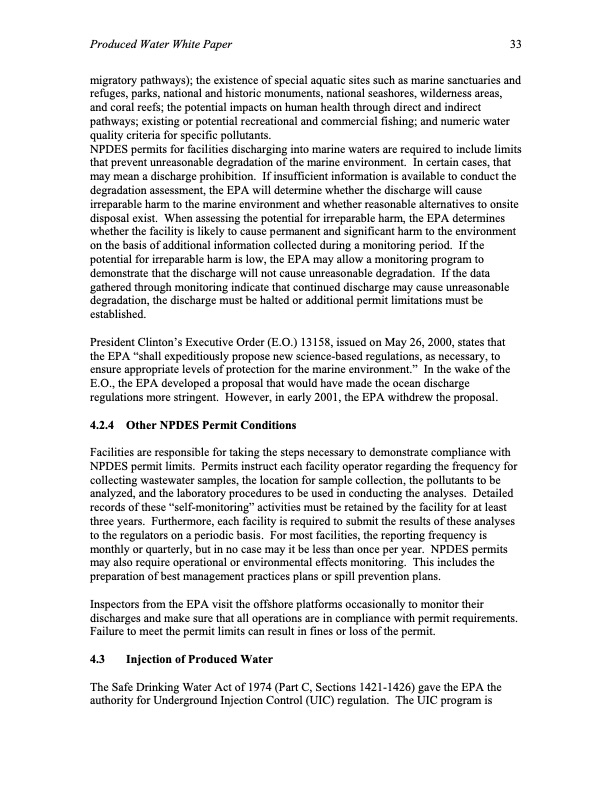
PDF Publication Title:
Text from PDF Page: 041
Produced Water White Paper 33 migratory pathways); the existence of special aquatic sites such as marine sanctuaries and refuges, parks, national and historic monuments, national seashores, wilderness areas, and coral reefs; the potential impacts on human health through direct and indirect pathways; existing or potential recreational and commercial fishing; and numeric water quality criteria for specific pollutants. NPDES permits for facilities discharging into marine waters are required to include limits that prevent unreasonable degradation of the marine environment. In certain cases, that may mean a discharge prohibition. If insufficient information is available to conduct the degradation assessment, the EPA will determine whether the discharge will cause irreparable harm to the marine environment and whether reasonable alternatives to onsite disposal exist. When assessing the potential for irreparable harm, the EPA determines whether the facility is likely to cause permanent and significant harm to the environment on the basis of additional information collected during a monitoring period. If the potential for irreparable harm is low, the EPA may allow a monitoring program to demonstrate that the discharge will not cause unreasonable degradation. If the data gathered through monitoring indicate that continued discharge may cause unreasonable degradation, the discharge must be halted or additional permit limitations must be established. President Clinton’s Executive Order (E.O.) 13158, issued on May 26, 2000, states that the EPA “shall expeditiously propose new science-based regulations, as necessary, to ensure appropriate levels of protection for the marine environment.” In the wake of the E.O., the EPA developed a proposal that would have made the ocean discharge regulations more stringent. However, in early 2001, the EPA withdrew the proposal. 4.2.4 Other NPDES Permit Conditions Facilities are responsible for taking the steps necessary to demonstrate compliance with NPDES permit limits. Permits instruct each facility operator regarding the frequency for collecting wastewater samples, the location for sample collection, the pollutants to be analyzed, and the laboratory procedures to be used in conducting the analyses. Detailed records of these “self-monitoring” activities must be retained by the facility for at least three years. Furthermore, each facility is required to submit the results of these analyses to the regulators on a periodic basis. For most facilities, the reporting frequency is monthly or quarterly, but in no case may it be less than once per year. NPDES permits may also require operational or environmental effects monitoring. This includes the preparation of best management practices plans or spill prevention plans. Inspectors from the EPA visit the offshore platforms occasionally to monitor their discharges and make sure that all operations are in compliance with permit requirements. Failure to meet the permit limits can result in fines or loss of the permit. 4.3 Injection of Produced Water The Safe Drinking Water Act of 1974 (Part C, Sections 1421-1426) gave the EPA the authority for Underground Injection Control (UIC) regulation. The UIC program isPDF Image | Produced Water from Production of Crude Oil

PDF Search Title:
Produced Water from Production of Crude OilOriginal File Name Searched:
ProducedWatersWP0401.pdfDIY PDF Search: Google It | Yahoo | Bing
NFT (Non Fungible Token): Buy our tech, design, development or system NFT and become part of our tech NFT network... More Info
IT XR Project Redstone NFT Available for Sale: NFT for high tech turbine design with one part 3D printed counter-rotating energy turbine. Be part of the future with this NFT. Can be bought and sold but only one design NFT exists. Royalties go to the developer (Infinity) to keep enhancing design and applications... More Info
Infinity Turbine IT XR Project Redstone Design: NFT for sale... NFT for high tech turbine design with one part 3D printed counter-rotating energy turbine. Includes all rights to this turbine design, including license for Fluid Handling Block I and II for the turbine assembly and housing. The NFT includes the blueprints (cad/cam), revenue streams, and all future development of the IT XR Project Redstone... More Info
Infinity Turbine ROT Radial Outflow Turbine 24 Design and Worldwide Rights: NFT for sale... NFT for the ROT 24 energy turbine. Be part of the future with this NFT. This design can be bought and sold but only one design NFT exists. You may manufacture the unit, or get the revenues from its sale from Infinity Turbine. Royalties go to the developer (Infinity) to keep enhancing design and applications... More Info
Infinity Supercritical CO2 10 Liter Extractor Design and Worldwide Rights: The Infinity Supercritical 10L CO2 extractor is for botanical oil extraction, which is rich in terpenes and can produce shelf ready full spectrum oil. With over 5 years of development, this industry leader mature extractor machine has been sold since 2015 and is part of many profitable businesses. The process can also be used for electrowinning, e-waste recycling, and lithium battery recycling, gold mining electronic wastes, precious metals. CO2 can also be used in a reverse fuel cell with nafion to make a gas-to-liquids fuel, such as methanol, ethanol and butanol or ethylene. Supercritical CO2 has also been used for treating nafion to make it more effective catalyst. This NFT is for the purchase of worldwide rights which includes the design. More Info
NFT (Non Fungible Token): Buy our tech, design, development or system NFT and become part of our tech NFT network... More Info
Infinity Turbine Products: Special for this month, any plans are $10,000 for complete Cad/Cam blueprints. License is for one build. Try before you buy a production license. May pay by Bitcoin or other Crypto. Products Page... More Info
| CONTACT TEL: 608-238-6001 Email: greg@infinityturbine.com | RSS | AMP |